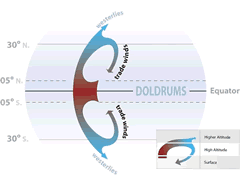Surface Ocean Currents
Currents Tutorial
In the Northern Hemisphere, warm air around the equator rises and flows north toward the pole. As the air moves away from the equator, the Coriolis effect deflects it toward the right. It cools and descends near 30 degrees North latitude. The descending air blows from the northeast to the southwest, back toward the equator (Ross, 1995). A similar wind pattern occurs in the Southern Hemisphere; these winds blow from the southeast toward the northwest and descend near 30 degrees South latitude.
These prevailing winds, known as the trade winds, meet at the Intertropical Convergence Zone (also called the doldrums) between 5 degrees North and 5 degrees South latitude, where the winds are calm. The remaining air (air that does not descend at 30 degrees North or South latitude) continues toward the poles and is known as the westerly winds, or westerlies. The trade winds are so named because ships have historically taken advantage of them to aid their journies between Europe and the Americas (Bowditch, 1995).
Currents Lessons
- Welcome
- Tidal Currents 1
- Tidal Currents 2
- Waves
- Longshore Currents
- Rip Currents
- Upwelling
- The Coriolis Effect
- Surface Ocean Currents
- Boundary Currents
- The Ekman Spiral
- Thermohaline Circulation
- The Global Conveyor Belt
- Effects of Climate Change
- Age of Exploration
- What is a "knot"?
- Shallow Water Drifter
- Deep Ocean Drifter
- Current Profiler
- Shore-based Current Meters
- How Currents Affect Our Lives?
- References
- Roadmap to Resources
- Subject Review
